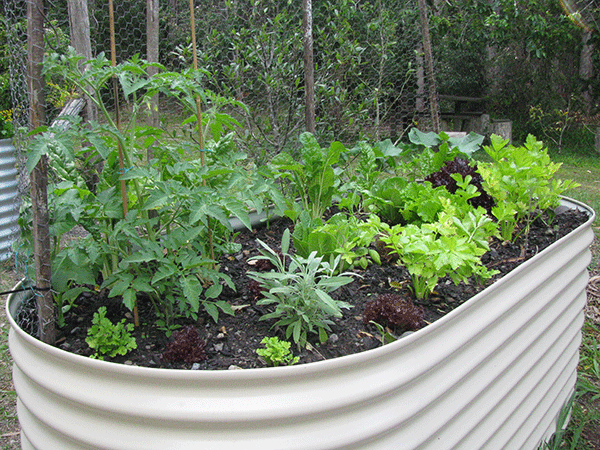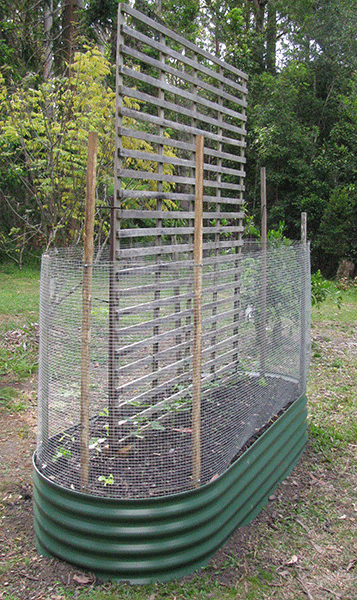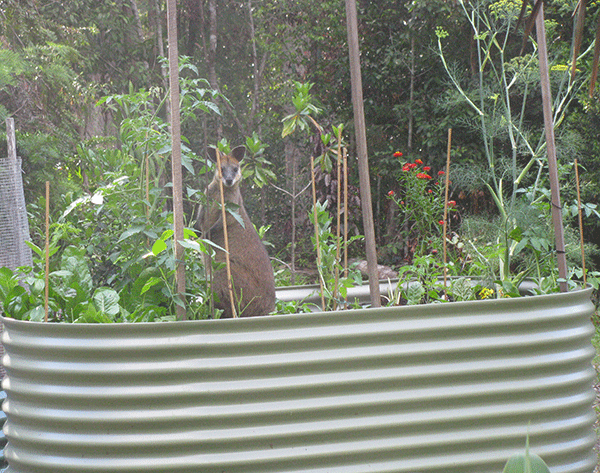Raised garden beds – pros and cons
I’ve got several pre-fabricated raised beds in my garden – the ‘tank’ type – and having used them for a few years, have got an idea of the good and bad points of this type of gardening. Here they are!
Pros
Saves your back: A 70 cm high raised bed brings the growing medium’s surface to a comfortable height. Little or no bending required!
Neat and contained: You can focus on one relatively small area, pack it full of veges and herbs and revel in your beautiful garden while all around may be chaos. The beds are easy to mow around.
Easy to cover: If a net is needed to keep fruit fly, other insects or birds out, it’s fairly straightforward to throw over the bed or over a frame.
Cons
It takes many barrow loads to fill the deeper beds and then, because the growing medium is usually compost, mulch etc, the level drops rapidly and needs frequent topping up. I’ve heard of people putting wrapped bales of mulch in the bottom of the beds to minimise the quantity of fill needed. Palm fronds or other material that breaks down slowly can also be used.
Soil structure – when my garden beds were newly filled, seedlings didn’t take off as well as I’d hoped. One possible cause of this was that the growing medium wasn’t dense enough – the roots didn’t have enough contact with the soil, so didn’t thrive. Water also drained too freely and quickly. A solution, especially in the early days of the raised bed, is to add some topsoil to the mix. Water saving crystals could also help.
What’s worked
Some veges work really well in raised beds, some don’t. Sweet potatoes did well in a round, 40 cm high bed and were easy to dig out. Peas, beans and tomatoes have grown well as have parsley, lettuce, silverbeet, rocket, broccoli, marigolds and basil.
What hasn’t
Potatoes: I planted the Green Harvest ‘Potato Salad Sensation’ mix – Cranberry Red, Sapphire and Kipfler – in the 70 cm high bed. They thrived and I congratulated myself until I realised that potatoes had to be DUG OUT. I’m glad no-one saw me using the stepladder to climb into the bed to do the harvesting!
Zucchinis: they did pretty well but in humid weather, the reduced airflow in the beds may have contributed to the powdery mildew problem. Also, as I have netted the beds to protect from insects, chooks and brush turkeys, the cucurbit family (cucumber, squash, zucchini, etc) had to be hand pollinated to ensure fruitset.
Tags: container gardening, herbs, organic, pest control, vegetables
Posted in Organic Gardening







I love my raised beds, probably would not plant potatoes or pumpkins in there but everything else. The main reason being that I don’t have to bend over! I was finding I just was not gardening much because it did my back in. They are also good for keeping things from keeling over from a too much water in a wet summer. They do need more watering though when it isn’t raining.
Interesting, thanks. It’s always good to hear real feedback from someone who’s tried an idea before I go ahead and do it myself.
What great photos!! Yes, potato do not work that well in raised garden beds that is the truth! But this looks great and you have some wonderful tips!
I have just put in a “Birdie’s” 2200 x 1350 x 800 raised bed. I placed Besser blocks in the bottom, to save on an extra metre of soil, then put 3 layers of heavy cardboard on top of these. On top of this I placed some shade cloth, to stop the soil from running through. It’s worked so far and saved me about 1 cub. metre of soil. I’ve also heard of people putting a metre of gravel in the bottom. Looking Good, Take care, Ian
I had to resort to these beds because of a rambunctious puppy. I used a variety of materials to fill them.
In two beds, I filled the bottom half with tightly packed logs and branches, topped with alternating green and brown layers, and only 30cm of soil on top. Xanthosoma, sweet potato and cassava all did well with this style of filling and required very little watering. After one year, the level has fallen by about 20 cm, but the year’s grace has given me time to gather enough compost to top them up.
The level in the beds where I used just alternating green and brown garden trash topped with soil have sunk MUCH more than the ones where I used logs, and I also had to water them more often.
I find that the edges of these raised steel beds can be dry and too warm, so I’ve been planting hardy protection on the outside of their North and West sides. Rosemary seems to like the reflected heat from the metal and has established rapidly, as has lemongrass.
And yes, digging cassava out of a raised bed is a bit of an undertaking!
My beds are light green and one fun thing about them is the ease of picking snails and slugs off the sides. Because they do not blend in, it is easy to spot them as they try to make their nightly trek up to the veggies.
All in all, I would rather garden at ground level, but the few problems of these beds are not insurmountable.
Yes good idea Ian with the bricks – I did put 1 metre of gravel in the bottom of mine and a layer of geotextile mat – like main road uses – to stop the soil going into the gravel. Worked fine… Cheers, Peter
I’m still having problems with possum proofing …….a method of securing the net to the raised bed while still having easy access for me! Any design ideas???? I’ve tried pegs, plastic pipe, metal clamps over plastic pipe…….
I make an arch with 2 star pickets and polypipe and put a bird net over the whole thing, held down with bricks. If you gather it all up in one place where you want to get in and out and put something really heavy on it seems to work. My favourite for my smaller raised beds is the latest from Green Harvest, the Fruit Saver Backyard Fruit Tree Net, keeps out fruit fly and cabbage moth too!
I have 6 raised beds in total, with a variety of “fill” in the bottom half of the bed. Most of mine are high (900mm) and quite big (3 are 6 metres long) so I truly can garden without bending over, so it was not really possible to fill them with quality soil/compost. The first 3 I made from old roofing iron and star pickets and filled them for the first 400mm with subsoil we dug out of a place where we were putting a water tank. We had the garden beds ready to fill, and when the backhoe arrived to prepare the site fro the water tank, we had the soil put in the garden beds by the backhoe. What a relief!
The most adventurous “fill” to date has been 2 layers of old tyres, filled with recycled jars and then covered in a bit of soil and then a layer of old pool liner sloped to drain out of some drain holes. This one was designed to be light, because it was against a concrete water tank and we were concerned about not having too much weight on one side.
I have just one small 4×4 feet raised bed in my backyard. It is just amazing how productive it is. I like it also because it is well incorporated in my overall garden design.
I have 2 raised beds near my chook yard. The soil there is thick with tree roots and unsuitable for inground beds. The raised beds were lined with layers of weed mat, then filled with a mixture of soil, compost and worm castings. I grow ‘clucker tucker’ in them from seed bought from Green Harvest. The girls have their own vege patch, and I have mine.
I have used old disused fridges for raised gardens,on their backs, doors and motors etc removed, holes drilled for drainage. I raised them off the ground, covered the drain holes with geotec cloth, used some rubble in the base, then a full layer of more geotec cloth, some wood ash [a way of using up our pile from winter fireplace], then anything I can lay my hands on. Home made compost, commercial mushroom compost, a mix of old horse, cow and other animal manure, some of our alpaca poo, our chook poo, and a bit of garden soil, plus some vermiculite to keep it open. I let it all settle and give it a big stir with an implement my husband made that is like a big cork screw. Works well, as I have had 3 hip replacements as well as dislocating one while gardening! I now have to design some shade, and work out how to stop the magpies pulling out my seed markers.[old ice cream paddle sticks]. The wire shelves from the fridges are reused as bird / shade protection, and it is still all a work in progress. There are 2 more fridges sitting in the yard waiting to be put in place. That will be 7 in all and probably enough, but who knows? The cabinet stays reasonably cool, they are free, look tidy, and I just love recycling! It is all set out on a slightly sloping area, on a black plastic sheeting, as I am not able to mow around them. I would love to use synthetic turf but that is probably taking it just too far! Just because I am no longer able to dig is no reason not to have veggies.
Hi Jan – loved your idea…but wouldn’t you have to take out the back or drill holes for drainage so they don’t become waterlogged? Just saw a freezer dumped “down the road” – hoping to get someone to bring it home for me. Disadvantage would be of course if one is alone these things would have to go in place never to be used again.
Does anyone see a disadvantage of using these? Paint composition? Stuff that leaks into soil? Of course they will eventually rust but imagine that’s a long time.
All of you making gardens with wood – I had termites last year and became fully aware of their power in the “world community” – I was one of the luckier ones but stiil very costly and a reminder of the impermanence of things – so maybe rethink the wood? I previously left hollow logs etc for the wild life, have sleepers as garden edging, etc.etc but am now rethinking…mind you I will probably still leave the logs for the animals 🙂 Jo
Hi, yes there are holes drilled in the base, and I make sure the frig is slightly sloping so as to help drainage. If I put them up off the ground, better drainage and no ants etc. It has been very successful and now have 7 with ability to take at least 2 more. I am about to have a knee replacement so they are just the ticket for gardening without bending. I only have to keep the magpies off the labels as they seem to like them! At present I have snow peas, heritage carrots, 2 types of onions, bock choy, spinach, strawbwrries, basil, garlic chives, miles of parsley, radish, tomatoes, lettuce, and can rotate easily. I love it! About to start another pile of “soil” with some chook poo from our chook yard, some alpaca poo, from our boys, and some great compost that has been brewing up. i put it all in a pile and then stir it with my corkscrew implement, and leave it till i need it. I plan an area just to keep the soil tidy by using the doors off the friges for surrounds. Just love recycling, and the friges are all insulated so less drying out and up off the ground helps with frosts. Jan
This is some really good information about garden bedding. It is good to know that it would be smart to plant things like potatoes or tomatoes. That does seem like a good thing to be aware of when you need to have an easy time getting to those plants.
Do you put plastic under the raised bed before you put the soil etc. in?